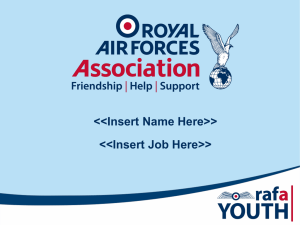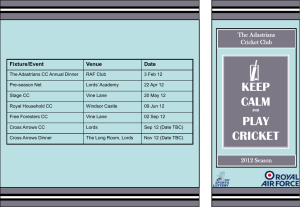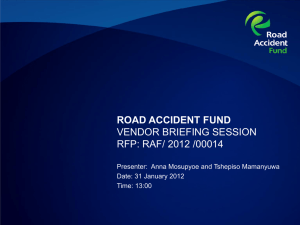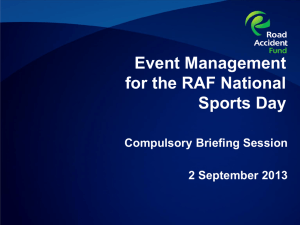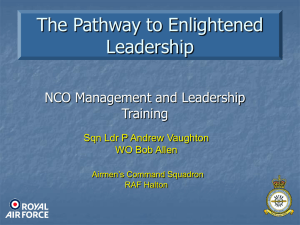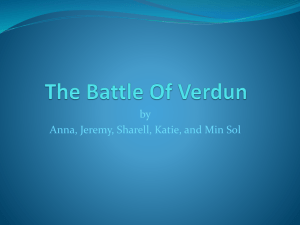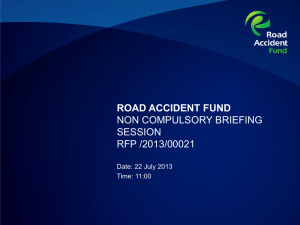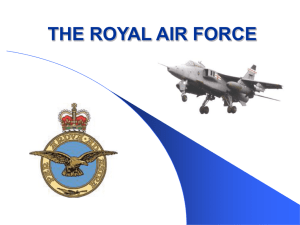The “Few” and the Many: RAF and Luftwaffe
advertisement
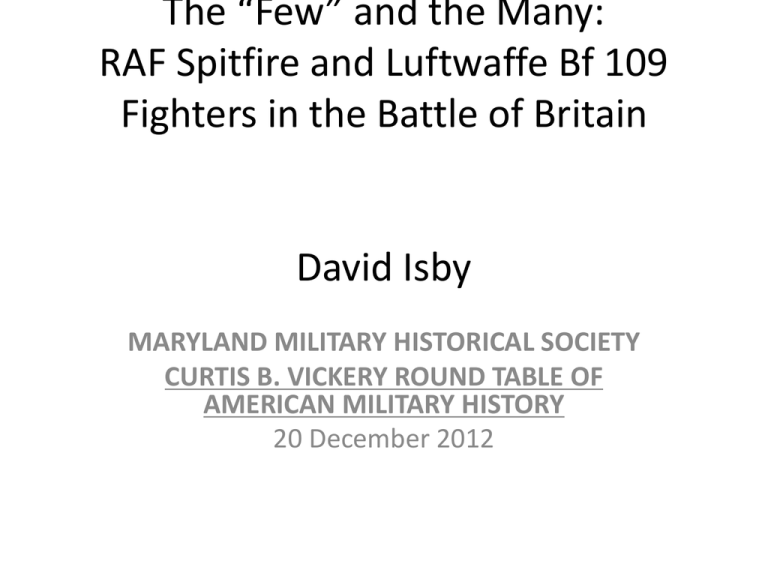
The “Few” and the Many: RAF Spitfire and Luftwaffe Bf 109 Fighters in the Battle of Britain David Isby MARYLAND MILITARY HISTORICAL SOCIETY CURTIS B. VICKERY ROUND TABLE OF AMERICAN MILITARY HISTORY 20 December 2012 The Decisive Duel: Spitfire vs 109 • • • • • • • “Dual biography” of the two Second World War fighter aircraft. Best known for their decisive roles in the Battle of Britain. Before the Battle, three key races, affecting the European balance of power. Race to design and fly the first modern fighter. Race to produce and deploy modern fighters. Race to integrate these fighters into effective war-fighting organizations. The first race starts in 1933. The last does not finish until the opening stages of the Battle of Britain. May 1940: Ability of Fighters to Exert Strategic Impact Demonstrated • The Luftwaffe’s Bf 109s won the war on 13-14 May 1940 over France. • No one but the German fighter pilots noticed it. • On 13 May, control of the air over the Meuse crossings allowed Luftwaffe to provide bombing that enabled advance. • On 14 May, defended bridges over the Meuse from air attack. • Showed how fighters could win a war, by enabling other forces (in this case the panzer divisions). Most air arms considered that only bombing could be decisive. • RAF, emphasizing strategic bombing, did not see how airpower could be decisive by enabling ground forces. • Germans were unable to convert this to a final success either militarily (Dunkirk) or diplomatically (no peace). Dunkirk, 1940 • • • • • RAF Fighter Command commits home defense forces in large number out of reach of UK-based radar (part of IADS). All but three squadrons of Fighter Command committed, provides needed combat experience (but losses of experienced pilots irreplaceable). First large-scale battles between Spitfires and Bf 109s. RAF has to defeat escorted bombers, not considered much pre-war. RAF has to chose between operating in squadrons (assuring coverage) or wings (assuring concentration). Choice becomes more important when Battle of Britain opens (and the time to form up the wing means will not be able to intercept before the bombers hit targets s. of London). The Messerschmitt Bf 109E and the Jagdwaffe • • • • • • Bf 109 was originally designed for air defense against bombers. Role changed with German offensive strategy. Spanish Civil War experience – showed other missions needed to perform. Twin-engine Bf 110 designed for offensive operations (longer range, HF radio, armament). Potentially highly lethal, used ineffective tactics. LW had advantage of superior tactics, good training, but way fighters used prevented them from using their strengths and made limitations (short range, no external tanks) key. Numerical superiority undercut by lack of spares, inability to rotate pilots. The Supermarine Spitfire & RAF Fighter Command • • • • • • Spitfire was doing what it was designed for, daylight air defense as part of Fighter Command, part of an integrated air defense system (IADS). Intended to defeat unescorted bombers. Fortunate that Hawker Hurricane had been in service a year before Spitfire. RAF learned how to fly modern fighters on the Hurricane just before Spitfire arrived. Hurricane has older design (high drag, slower speed though same engine as Spitfire) but some older structural elements helps for production/repair. Combat experience shows that the side with the best fighter can inflict large losses on numerically superior but less performing opponents – like Hurricanes without Spitfires. Building the Spitfire and 109 • • • • • • • September 40 – Britain produces 470 single-engine fighters, Germany produces 178. Britain cuts production of spares to 6 pct of output – short-term surge. Germans have multiple factories for 109 (Erla, Fiesler, Arado, AGO). UK 1 . German mobilization goes ahead, but inefficient, committed to early victory. WW2 in air underlines importance of industry & operational capability. Second Spitfire factory (Castle Bromwich. Designed for assembly line) coming on line in summer 1940, building Spitfire II. Spitfire production centred at Southampton, bombed out in late September, importance of second line, Hurricane production. Setting up the Battle • • • • • • After Dunkirk, Britain surges industrial production, adds pilots (foreign), improves existing aircraft (100 0ctane fuel, armour, some self-sealing fuel tanks, constant speed propellers) absent before. Operates at prewar bases, near factories. LW in constant action since 10/5/40, no rotation of pilots, short on munitions, fuel, spare parts. (Limiting numbers of airplanes they can put up in Battle). Operates from improvised fields in France, at end of long and non-responsive supply lines. LW had looked at potential of having to wage air war through bombing (though a 38 kriegsspiel showed the best way to win was hit ports in conjunction with U-boats). But both sides largely improvise. 10 July – 8 August: Opening Stages • • • • • 10 July-8 August. Opening stage. Attacks on Channel shipping, try and draw RAF into air battles where LW numbers will prevail. RAF fights limited liability battles, concentrates on preparing for main battle. Germans plan for and prepare invasion, though Hitler does not take a hands-on role. Fuhrer War Directive 16, 16/7, orders preparations. Offers final demand for peace. But LW leadership does not come up with a viable way to defeat RAF in limited time (October latest possible invasion) 13 August – start of offensive against RAF. Failure to prevail sets next phase of Battle. 15 August: “Black Thursday” • • • • • • • • 15 August was to be “Alder Tag”. Shows importance of weather. Improvised after failures of 13 August. Show vulnerability of Bf 110, unescorted bombers over Britain. Powerful blows against radars, aircraft factories, airfields largely wasted because Germans could not assess, did not know when needed to repeat, or what was important to winning the Battle (did not focus on fighter fields or factories) Show bombers could not survive without escorts. Therefore, key limit is number of fighters (NOT bombers ) that can be put in air. Short range of Bf 109 – could cover invasion beaches but defeating RAF problematic. 8 August – 6 September: Attacks on Airfields, Aircraft Industries • • • • • • Most intense attacks on RAF targets. Last 10 days of August, RAF loses 126 fighter pilots (14 pct of total, 60 pct of them experienced and hence irreplaceable). Germans lack of intelligence, systematic targeting, effective doctrine. RAF short of pilots, but able to rotate squadrons to north. Germans continue buildup of invasion barges despite intense RAF bombing. Importance of intelligence, ULTRA, photo recon, to British. 15 September: The Decisive Day? • • • • • • • 15 September “Battle of Britain Day”. Germans send two escorted mass daylight raids against London. Neither does well. Map shows the afternoon raid as it heads for London over a massive frontage. Gets hit by 11 Group “squadron forward” en route and 12 Group “big wing” over London While RAF claims massively exaggerated, evident to Germans that they remain strong. Hitler orders invasion postponed 17 September, though had been leaning towards that before. Transition: From the Battle to the Blitz, September 1940 – May 1941 • • • • • • • LW has to improvise an independent air war at night after daylight attacks fail. Something they had invested in, why have KG 100 and navigation aids (RAF, which embraced independent air war, lacks). Germans reluctant to shift to night operations until after RAF bombs Berlin . Shift to night bombing plays to LW strength, RAF weakness (Fighter Command IADS day-only). British have to improvise night air defenses, only start to become effective as the Blitz is ending. Continue to refine defenses. 1944 “Baby Blitz” utter failure. Germans cannot counter Allied bomber offensives (V-1/2). The Battle in History • • • • • British tend to see it as climactic action, end of March of Conquest that started in Rhineland, sent message to US, Soviets. Saving of western civilization. Germans see it as part of March of Conquest that ended at Stalingrad, see the daylight (8-9/40) offensive as the less successful opening stage of the (largely night) air offensive running to 5/41. See invasion threat as not credible. Battle was a tactical adjustment in a battle they win. Germans point to losses suffered by RAF offensive operations against invasion ports. It would be 1942 before RAF could achieve LW level of night bombing effectiveness. Difficulty/importance of narrative. The final “race” is to determine who wins.
